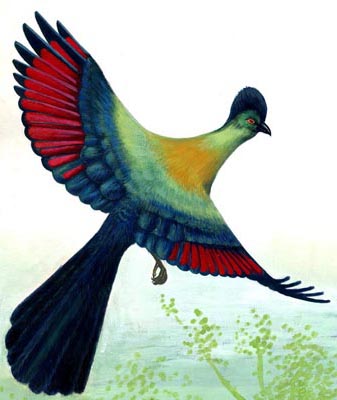The ENTC now has a new website, at www.entc.org.sz
Our logo is adapted from a painting by Phillip Dlamini, 1998, of a purple crested turaco. In traditional Swazi dress, the red feathers feature in the royal headdress, so this bird illustration is not only a symbol for wildlife conservation, but also of cultural heritage.


(Updated March 2008, information from Sandile Gumedze.)
Malolotja Environmental Education Programme was officially opened in 1989, though its operations date back to 1985. The main purpose of the centre is to promote and strengthen environmental education & awareness in the youth of Swaziland.
The centre is situated next to the Malolotja River, which makes it easy and convenient for birds (both terrestrial and aquatic species) enthusiasts. Next to the centre is a natural forest serving as a habitat for both floral and faunal species such as bush pigs and small antelope.
The centre has 6 dormitories for environmental education visiting groups, which accommodates a total of 24visitors and the maximum number of visitors per dormitory is 6people. One dormitory is used by leaders / teachers of the visiting group and caters for 4 people.
Ablution facilities are available at the centre for both genders (male and females) and have warm water heating system using; fuel wood (donkey boiler), electricity geysers, and water solar powered system cards on the roof of the ablution block.
Bookings to the centre are essential and should be made well in advance of the intended visit mainly to secure the desirable dates and allow proper planning by the EEC staff. The correspondence should be sent to the Senior Education Officer, who in turn replies to all requests made by potential visitors to the centre.
The centre provides the environmental education service at a subsidized cost to the Swazi public and international visitors. Groups anticipating a visit are advised to request an up-to-date tariff structure at the centre from the Senior Environment Education Officer.
Our Contacts:
Head Quarters: (+268) 2416 1489/1179
Email: info@sntc.org.sz
King Sobhuza II Park: (+268) 2416 1489/1179
Email: ksmp@sntc.org.sz
National Museum: (+268) 2416 1489/1179
Email: curator@sntc.org.sz
Copyright © ESWATINI NATIONAL TRUST COMMISSION
Malolotja Nature Reserve: (+268) 2444 3241 / (+268) 2416 1480
Email: culturalvillage@sntc.org.sz
Mantenga Nature Reserve and Swati Cultural Village: 2416 1151/1178
Email: culturalvillage@sntc.org.sz
Mlawula Nature Reserve: (+268) 2383 8885 (Reception)
(+268) 2383 8453 (Senior Warden)
Email: culturalvillage@sntc.org.sz
Magadzavane Lodge: (+268) 2343 5108/9
Email: magadzavane@sntc.org.sz